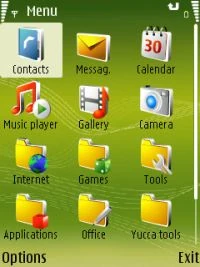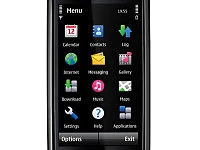
Symbian S60v3 (3rd Edition) menu on a Nokia N73.

Symbian S60v5 (5th Edition) menu on a Nokia 5800.
The S60 Platform (formerly Series 60 User Interface) is a software platform for smartphones that runs on the Symbian operating system. It was created by Nokia in 2001, and was first released in 2002 with the Nokia 7650 smartphone. The OS platform has since seen 5 updated editions. In 2010, S60 was replaced by the new Symbian^3.
S60 consists of a suite of libraries and standard applications, such as telephony, personal information manager (PIM) tools, and Helix-based multimedia players. It is intended to power fully featured modern phones with large colour screens, which are commonly known as smartphones
The S60 software is a multivendor standard for smartphones that supports application development in Java MIDP, C++, Python[1] and Adobe Flash. Originally, the most distinguishing feature of S60 phones was that they allowed users to install new applications after purchase. Unlike a standard desktop platform, however, the built-in apps are rarely upgraded by the vendor beyond bug fixes. New features are only added to phones while they are being developed rather than after public release. Certain buttons are standardized, such as a menu key, a four way joystick or d-pad, left and right soft keys and a clear key.
S60 is mainly used by Nokia but has also been used by a few other manufacturers, including Lenovo, LG Electronics, Panasonic, Samsung,[2] Sendo,[3] and Siemens Mobile.
In addition to the manufacturers the community includes:
- Software integration companies such as Sasken, Elektrobit, Teleca, Digia, Mobica, Atelier.tm
- Semiconductor companies Texas Instruments, STMicroelectronics, Broadcom, Sony, Freescale Semiconductor, Samsung Electronics
- Operators such as Vodafone and Orange who develop and provide S60-based mobile applications and services
- Software developers and independent software vendors (ISVs).
Series 60 was renamed as S60 in November 2005.
S60 editions[]
There have been four major releases of S60: "Series 60" (2001), "Series 60 Second Edition" (2003), "S60 3rd Edition" (2005) and "S60 5th Edition" (2008).
- S60 1st Edition
- In Series 60 1st Edition, the devices' display resolution was fixed to 176×208.
- S60 2nd Edition
- Also known as S60v2. Starting with 2nd Edition Feature Pack 3 (S60v2.3), Series 60 supports multiple resolutions, i.e. Basic (176×208), and Double (352×416). Nokia N90 was the first S60 device to support a higher resolution (352×416). Some devices, however, have non-standard resolutions, like the Siemens SX1, with 176×220. Nokia 5500 Sport has a 208×208 screen resolution, and the Nokia E90 with its wide 800×352 inner display.
- S60 3rd Edition
- S60v3 uses a hardened version of Symbian OS (v9.1), which has mandatory code signing. In S60v3, a user may install only programs that have a certificate from a registered developer, unless the user disables that feature or modify the phone's firmware through third-party hacks that circumvent the mandatory signing restrictions. This makes software written for S60 1st Edition or 2nd Edition not binary-compatible with S60v3.
- In 2006, a "Designed for S60 Devices" logo program for developers was launched. The logotype can be used with conforming programs regardless of them being native Symbian or Java.
- S60 5th Edition
- In October 2008, S60 5th Edition was launched. Nokia decided to move from 3rd Edition directly to 5th Edition "as a polite gesture to Asian customers",[4] because the number four means bad luck in some Asian cultures). S60 5th Edition runs on Symbian OS version 9.4.[5] The major feature of 5th Edition is support for high-resolution 640×360 touchscreens; before 5th Edition, all S60 devices had a button-based user interface. S60 5th Edition also integrates standard C/C++ APIs and includes Adobe Flash Lite 3.0 with S60-specific ActionScript extensions that give Flash Lite developers access to phone features like contacts, text messaging, sensors and device location information (GPS).
- The S60 5th Edition is the last edition of S60. Its assets along with Symbian OS, UIQ and MOAP(S) have been used as a base for Symbian, an open source operating system being developed by the Symbian Foundation. The first edition of Symbian, Symbian^1, uses S60 5th Edition on top of Symbian OS 9.4 as its base.
S60 versions and supported devices[]
Many devices are capable of running the S60 software platform with the Symbian OS. Devices ranging from the early Nokia 7650 running S60 v0.9 on Symbian OS v6.1,[6][7] to the latest Samsung i8910 Omnia HD running S60 v5.0 on Symbian OS v9.4.[8] In Symbian^3 the version of the revised platform is v5.2.
The table lists devices carrying each version of S60 as well as the Symbian OS version it is based on. Note that new devices since Symbian^3 May be capable of upgrading to later systems, such as Symbian Anna and Symbian Belle. Therefore, you may see a device being listed in many systems.
| Product Name | S60 Version Number |
Symbian OS Version Number |
Devices[6][7][8] |
|---|---|---|---|
| S60 1st Edition | 0.9 | 6.1 | |
| S60 1st Edition, Feature Pack 1 |
1.2 | 6.1 |
|
| S60 2nd Edition | 2.0 | 7.0s |
|
| S60 2nd Edition, Feature Pack 1 |
2.1 | 7.0s | |
| S60 2nd Edition, Feature Pack 2 |
2.6 | 8.0a |
|
| S60 2nd Edition, Feature Pack 3 |
2.8 | 8.1a | |
| S60 3rd Edition | 3.0 | 9.1 |
|
| S60 3rd Edition, Feature Pack 1 |
3.1 | 9.2 |
|
| S60 3rd Edition, Feature Pack 2 |
3.2 | 9.3 |
|
| S60 5th Edition (Corresponds to Symbian^1) |
5.0 | 9.4 |
|
| Symbian^2 | Template:Citation needed | Template:Citation needed |
|
| Symbian^3 | 5.2 | 9.5 |
|
| Symbian Anna | 5.2 | 9.5 |
|
| Nokia Belle (Renamed from Symbian Belle) |
5.3 [10] | 101 [11] |
|
| Nokia Belle, Feature Pack 1 |
5.4 [12] | 101 [13] |
|
| Nokia Belle, Feature Pack 2 |
5.5 [12] | 101 [14] |
|
Symbian is now progressing through a period of organisational change to metamorph into an open source software platform project. As an OS, Symbian OS originally provided no user interface (UI), the visual layer that runs atop an operating system. This was implemented separately. Examples of Symbian UIs are MOAP; Series 60; Series 80; Series 90 and UIQ. This separation of UI from underlying OS has created both flexibility and some confusion in the market place. The Nokia purchase of Symbian was brokered with the involvement of the other UI developers and all major user interface layers have been (or have been pledged to be) donated to the open source foundation who will independently own the Symbian operating system. The new Symbian Foundation has announced its intent to unify different Symbian UIs into a single UI based on the S60 platform. (Announcements made in March 2009 indicated this would be the S60 5th edition with feature pack 1).
Symbian Anna[]
On 12 April 2011, Nokia announced Symbian Anna as a software update to the Symbian^3 release. Three new devices (500, X7 and E6) were announced which will have Symbian Anna pre-installed. Symbian Anna will be available as a Software Update for Symbian^3 based devices as well. Most Significant updates that come with "Anna" are
- Portrait QWERTY with split-view data entry
- New Icon Set
- New internet browser with an improved user interface, search-integrated address field, faster navigation and page loading.
- Updated Ovi Maps (search public transport, download full country maps via WLAN or Nokia Ovi Suite, check-in to Facebook, Twitter and Foursquare).
- Java Runtime 2.2, Qt Mobility 1.1 and Qt4.7.
Symbian Belle[]
On August 24 2011, Nokia announced Symbian Belle as a software update to the Symbian Anna release. Three new devices (603, 700 and 701) Nokia 600 is cancelled and is replaced with Nokia 603 were announced which will have Symbian Belle pre-installed. Symbian Belle will be available as a Software Update for Symbian Anna based devices as well. Most Significant updates that come with "Belle" are
- Free-form, differently-sized, live widgets
- More homescreens
- Improved status bar
- Dropdown menu
- Modernised navigation
- New apps
- Informative lock screen
- NFC devices
- Visual multitasking
Competitions and the End of Symbian[]
In February 2011, Nokia announced a partnership with Microsoft to integrate Windows Phone 7 as their Primary OS, leaving further Symbian development in question. Nokia has promised support for Symbian and its newer devices till at least 2016, but no new Symbian devices will be released after Nokia 808 PureView. As a part of this plan, Nokia announced on April 29 2011, to transfer and outsource Symbian activities to Accenture along with 3000 employees.
See also[]
- Sailfish OS, the open source Linux platform based on MeeGo from Jolla, the company which was established by ex-Nokia employees.
- Android OS, an partly open-source mobile platform by Google
- Maemo, Nokia's Debian Linux-based platform
- MOAP, another Symbian-based platform
- Series 40, Nokia's non-Symbian-based platform for mass-market devices.
- Series 80
- Series 90
- UIQ, another Symbian-based platform
- Web Browser for S60
References[]
Symbian Belle
Symbian Belle – the facts, the features and the pictures
External links[]
Template:En:wikibooks
- Forum Nokia - S60 developer site
- Forum.Nokia.com - S60 2nd/3rd Edition: Differences in Features v1.5
- Forum Nokia Russia - S60 developer site
- Open Letter from Nokia CEO to Microsoft CEO
Template:Symbian platform Template:Nokia platforms Template:Nokia phones
- ↑ Template:Citation
- ↑ Template:Citation
- ↑ Pakalski, Ingo (21 October 2003). Symbian-Smartphone von Sendo mit Digitalkamera samt Blitz (German). Golem.de. Archived from the original on October 26, 2003. Retrieved on 15 January 2011.
- ↑ S60 5th Edition and the Nokia 5800 XpressMusic are here!, 3rd comment
- ↑ is now closed. S60.com. Archived from the original on December 5, 2008. Retrieved on 13 March 2011.
- ↑ 6.0 6.1 Forum Nokia Device Specifications for S60 models(operating system information)
- ↑ 7.0 7.1 Sony Ericsson Satio Press Release (information about S60 version)
- ↑ 8.0 8.1 8.2 Samsung OMNIAHD Dazzles at Mobile World Congress with Its HD Brilliance
- ↑ 9.0 9.1 Fast moving phone viruses appear. BBC (30 December 2004). Retrieved on 16 January 2011.
- ↑ Screenshot with Nokia 600[dead link]
- ↑ Z:\resource\versions\platform.txt
- ↑ 12.0 12.1 [1]
- ↑ Z:\resource\versions\platform.txt
- ↑ Z:\resource\versions\platform.txt